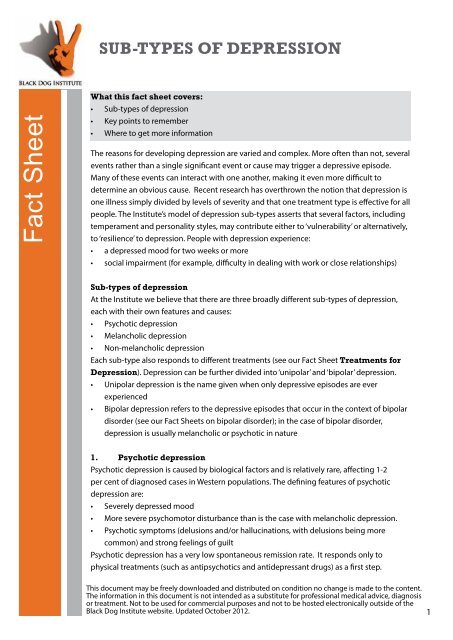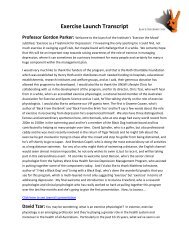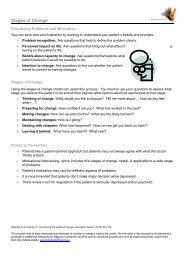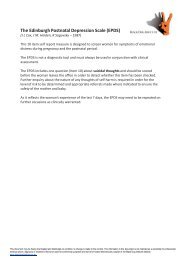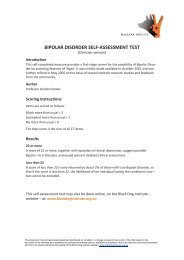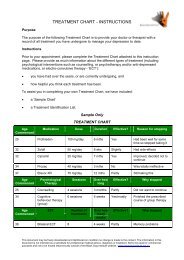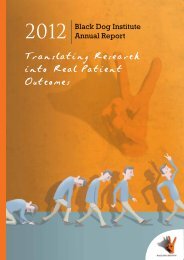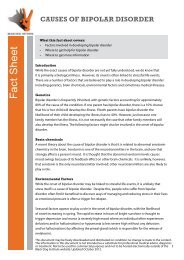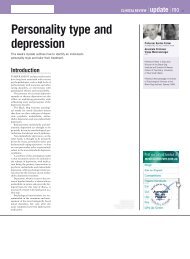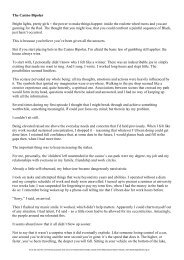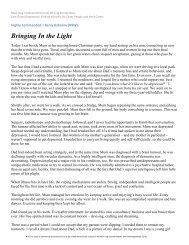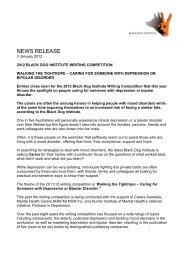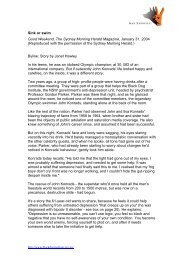Sub-types of depression - Black Dog Institute
Sub-types of depression - Black Dog Institute
Sub-types of depression - Black Dog Institute
Create successful ePaper yourself
Turn your PDF publications into a flip-book with our unique Google optimized e-Paper software.
SUB-TYPES Of DEPRESSIONFact SheetWhat this fact sheet covers:• <strong>Sub</strong>-<strong>types</strong> <strong>of</strong> <strong>depression</strong>• Key points to remember• Where to get more informationThe reasons for developing <strong>depression</strong> are varied and complex. More <strong>of</strong>ten than not, severalevents rather than a single significant event or cause may trigger a depressive episode.Many <strong>of</strong> these events can interact with one another, making it even more difficult todetermine an obvious cause. Recent research has overthrown the notion that <strong>depression</strong> isone illness simply divided by levels <strong>of</strong> severity and that one treatment type is effective for allpeople. The <strong>Institute</strong>’s model <strong>of</strong> <strong>depression</strong> sub-<strong>types</strong> asserts that several factors, includingtemperament and personality styles, may contribute either to ‘vulnerability’ or alternatively,to ‘resilience’ to <strong>depression</strong>. People with <strong>depression</strong> experience:• a depressed mood for two weeks or more• social impairment (for example, difficulty in dealing with work or close relationships)<strong>Sub</strong>-<strong>types</strong> <strong>of</strong> <strong>depression</strong>At the <strong>Institute</strong> we believe that there are three broadly different sub-<strong>types</strong> <strong>of</strong> <strong>depression</strong>,each with their own features and causes:• Psychotic <strong>depression</strong>• Melancholic <strong>depression</strong>• Non-melancholic <strong>depression</strong>Each sub-type also responds to different treatments (see our Fact Sheet Treatments forDepression). Depression can be further divided into ‘unipolar’ and ‘bipolar’ <strong>depression</strong>.• Unipolar <strong>depression</strong> is the name given when only depressive episodes are everexperienced• Bipolar <strong>depression</strong> refers to the depressive episodes that occur in the context <strong>of</strong> bipolardisorder (see our Fact Sheets on bipolar disorder); in the case <strong>of</strong> bipolar disorder,<strong>depression</strong> is usually melancholic or psychotic in nature1. Psychotic <strong>depression</strong>Psychotic <strong>depression</strong> is caused by biological factors and is relatively rare, affecting 1-2per cent <strong>of</strong> diagnosed cases in Western populations. The defining features <strong>of</strong> psychotic<strong>depression</strong> are:• Severely depressed mood• More severe psychomotor disturbance than is the case with melancholic <strong>depression</strong>.• Psychotic symptoms (delusions and/or hallucinations, with delusions being morecommon) and strong feelings <strong>of</strong> guiltPsychotic <strong>depression</strong> has a very low spontaneous remission rate. It responds only tophysical treatments (such as antipsychotics and antidepressant drugs) as a first step.This document may be freely downloaded and distributed on condition no change is made to the content.The information in this document is not intended as a substitute for pr<strong>of</strong>essional medical advice, diagnosisor treatment. Not to be used for commercial purposes and not to be hosted electronically outside <strong>of</strong> the<strong>Black</strong> <strong>Dog</strong> <strong>Institute</strong> website. Updated October 2012.1
SUB-TYPES Of DEPRESSIONFact Sheet2. Melancholic <strong>depression</strong>Melancholic <strong>depression</strong> is also a biological <strong>depression</strong>. Its defining features are:• A more severe depressed mood than is the case with non-melancholic <strong>depression</strong>• Psychomotor disturbance such as slowed or agitated physical movements and slowedcognitive processing abilitiesMelancholic <strong>depression</strong> is a relatively uncommon type <strong>of</strong> <strong>depression</strong>. It affects only2-10 per cent <strong>of</strong> diagnosed cases in Western populations. The percentage <strong>of</strong> affected menand women is roughly the same.Melancholic <strong>depression</strong> has a low rate <strong>of</strong> spontaneous remission, meaning it very rarelygoes away <strong>of</strong> its own accord. It responds best to physical treatments (e.g. antidepressantdrugs) and only minimally (at best) to non-physical treatments such as counselling orpsychotherapy as a first step. However, psychological interventions can be helpful oncethe symptoms have subsided and during the recovery period.3. Non-melancholic <strong>depression</strong>Non-melancholic <strong>depression</strong>s have to do with psychological causes, personalitycharacteristics and are <strong>of</strong>ten linked to stressful events in a person’s life. Non-melancholic<strong>depression</strong> is the most common <strong>of</strong> the three <strong>types</strong> <strong>of</strong> <strong>depression</strong> but it can be hardto accurately diagnose because it lacks the defining characteristics <strong>of</strong> the other twodepressive <strong>types</strong> (namely psychomotor disturbance or psychotic features). In contrast tothe other <strong>types</strong> <strong>of</strong> <strong>depression</strong>, non-melancholic <strong>depression</strong> has a high rate <strong>of</strong> spontaneousremission which means that the <strong>depression</strong> resolves over time by itself. This is becausenon-melancholic <strong>depression</strong> is <strong>of</strong>ten linked to stressful life events which, when resolved,tend to result in the <strong>depression</strong> also lifting. Non-melancholic <strong>depression</strong> responds well toa range <strong>of</strong> treatment options including psychological interventions, antidepressants andcounselling.Key points to remember• There are three different sub-<strong>types</strong> <strong>of</strong> <strong>depression</strong>, each with their own features andcauses• Knowing what sub-type <strong>of</strong> <strong>depression</strong> a person has is important in being able to selectthe best treatment options• Psychotic and melancholic <strong>depression</strong> are a more biological sub-type <strong>of</strong> <strong>depression</strong>,resulting in more severely depressed mood and psychomotor disturbance• Non-melancholic <strong>depression</strong> is the most common form <strong>of</strong> <strong>depression</strong> and is <strong>of</strong>tenlinked to stressful life events, personality and coping styles.www.blackdoginstitute.org.auThis document may be freely downloaded and distributed on condition no change is made to the content.The information in this document is not intended as a substitute for pr<strong>of</strong>essional medical advice, diagnosisor treatment. Not to be used for commercial purposes and not to be hosted electronically outside <strong>of</strong> the<strong>Black</strong> <strong>Dog</strong> <strong>Institute</strong> website. Updated October 2012.2


